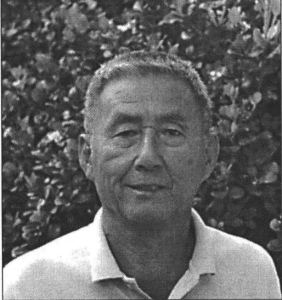Herbert S. Nishimoto

Tsunamis Remembered: Oral Histories of Survivors and Observers in Hawai‘i
Life history interviews with individuals who witnessed and survived tsunamis-particularly the 1946 and 1960 disasters on the Big Island of Hawai'i. Thirty individuals-mostly residents of Hilo and Laupahoehoe-recall their experiences before; during, and after the 1946 and 1960 tsunamis which were arguably the most destructive natural disasters in modem Hawaiian history.
Herbert Sadamu Nishimoto was born June 15, 1929 in N"mole, Hawai'i. He is the youngest of Senichi Nishimoto and Misano Masukawa Nishimoto's five children. Immigrants from Hiroshima, Japan, Senichi and Misano Nishimoto ran a small grocery store in Honohina, a toWn resided in by workers of Hakalau Plantation Company and their families. When not helping his parents in the store or working for twenty-five cents a day at the sugar plantation, Nishimoto spent his boyhood swimming and fishing in the nearby streams, pig hunting, and participating in sports leagues organized by the plantations. He also tended the family garden, poultry, and livestock. Nishimoto attended John M. Ross School, Hilo Intermediate School, and Laupahoehoe High School, graduating with the class of 1948. He was finishing up his sophomore year when the 1946 tsunami swept across Laupahoehoe Point on the morning of April 1. Nishimoto was swept out to sea by the tsunami. Surviving first on a makeshift raft he made from debris, and later on a raft dropped to him from a rescue plane, he spent the night in the open ocean. Battling fear, hunger, thirst. exposure, fatigue, and an occasional shark, he and two companions drifted for miles. They were rescued the next day near Niuli'i, South Kohala. Nishimoto's extraordinary story has been documented in newspaper articles, books, and videotape. Nishimoto, a veteran of the Korean and Vietnam wars, retired after twenty-seven years in the U.S. Army. He lives in 'Aiea, O'ahu with his wife, Jessie Moriyasu Nishimoto. They raised three children and currently have seven grandchildren.
Scope and Content Note
Ninole-born man describes plantation life, including his parents and their contract sugarcane field and family grocery store. He describes his swimming workouts and other outdoor activities. He gives a detailed account of the 1946 tsunami: being dragged out to sea by the third wave, floating on makeshift raft, meeting two other survivors, climbing aboard a raft dropped from a plane and being rescued. He also talks about his recruitment into military service, Vietnam experience, and his philosophy based on the events of his life.
Program Note:
This interview is part of the Center for Oral History's project Tsunamis Remembered: Oral Histories of Survivors and Observers in Hawai‘i. Interviews from this project are available in the Center's ScholarSpace open access repository.
The Center for Oral History (COH), in the Department of Ethnic Studies at the University of Hawaiʻi at Mānoa, collects, documents, preserves and highlights the recollections of Native Hawaiians and the multi-ethnic people of Hawaiʻi. It produces oral histories and interpretive historical materials about lifeways, key historic events, social movements and Hawaiʻi’s role in the globalizing world, for the widest possible use.
Please Note: The oral histories in this collection are protected by copyright and have been created for educational, research and personal use as described by the Fair Use Doctrine in the U.S. Copyright law. Please reach out Voices@noaa.gov to let us know how these interviews are being used in your research, project, exhibit, etc. The Voices staff can help provide other useful resources related to your inquiry.
The NOAA mission is to understand and predict changes in climate, weather, oceans, and coasts, to share that knowledge and information with others, and to conserve and manage coastal and marine ecosystems and resources. The Voices Oral History Archives offers public access to a wide range of accounts, including historical materials that are products of their particular times, and may contain offensive language or negative stereotypes.
Voices Oral History Archives does not verify the accuracy of materials submitted to us. The opinions expressed in the interviews are those of the interviewee only. The interviews here have been made available to the public only after the interviewer has confirmed that they have obtained consent.
